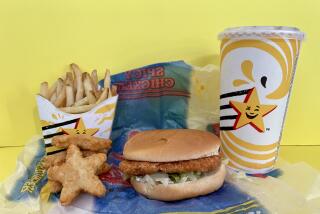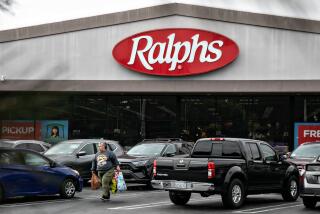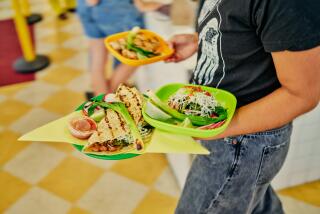Diners digest the new menu facts
- Share via
Californians have a rep, deserved or not, for being health conscious — asking for dressing on the side and meats that are grilled instead of fried. So are they leaping to devour the nutrition data now available in restaurants? And what surprises does the information hold?
To get a sense, we visited a few local eateries. At the places we went to, information was usually on the table or, if not, brought quickly when asked for — but we spotted very few patrons interested enough to check it out.
Sure, a few diligently study it. Some are only dimly aware of it. And others know about it but don’t think they need it.
At a Hollywood Denny’s, we found Los Angeles-based graphic designer Anthony Briggs, 58, having dinner with a friend. “I don’t take it into account,” he said of the nutrition facts sitting on the table with the condiments. He doesn’t need to, he added: A heart attack 20 years ago made him aware of the cholesterol and saturated fat in what he eats — he navigates menus with care and leaves plenty on his plate.
He usually orders the same things. Tonight it was barbecued chicken (650 calories and 3 grams of saturated fat before factoring in the side dishes).
Briggs thinks the information should be available. “And I think people should pay attention, but I’m pretty sure they don’t.”
Where we found the information: on a brochure provided with the menus.
The good, bad and ugly: No one goes to Denny’s expecting health food, but there are some decent choices, most under the “Fit Fare” label. The Fit Fare grilled chicken breast sandwich, which comes with fruit, is 450 calories. Cobble together a breakfast of two egg whites, four strips of turkey bacon, fruit and an English muffin with margarine for a reasonable 426 calories. Most of the hamburgers are what you’d expect — 940 calories for a bacon cheddar burger — and chicken strips will run you 560 calories without the sides. Beware the “Rock Star Menu,” on which the Los Lonely Boys Texican Burger is 1,020 calories and 19 grams of saturated fat, and the Hooburrito is 1,430 calories and 15 grams of saturated fat.
At an IHOP in L.A.’s Miracle Mile district the next morning, 16-year-old Jasmine Gums of Inglewood was sitting with her mother, Margaret Mallard of L.A. Gums was eating an egg white omelet with spinach; her mother was halfway through her eggs, hash browns and sausage. Both approve of the law — Gums said she was startled when she saw the calorie counts for the first time at a Mimi’s Cafe. She knows calories well enough to choose something healthful, she added, but still enjoys perusing the nutritional info.
Mallard says she occasionally peeks at the numbers, noting details such as the saturated fat. But it doesn’t influence what she orders: “I’m just in general a bad eater. I knew I was going to have pancakes. My daughter looks at the menu and says, ‘This has too many calories,’ But me,” she adds, laughing, “I’ll just get a Diet Coke to compensate.”
Both thought the labeling law was a good idea: “Some people are health conscious,” Gums said, “and they like to know what they’re eating.”
Where we found the information: written on the menu.
The good, bad and ugly: “IHOP for Me” is where you’ll find the restaurant’s under-600-calorie offerings for adults and kids, such as the blueberry harvest grain-and-nut combo for 570 calories and the tilapia hollandaise for 370 calories. Watch out for the quick two-egg breakfast at 850 to 890 calories (the bigger number indicates higher-calorie side dishes) and the chicken clubhouse super stacker sandwich at 1,080 to 1,490 calories. Beware the super-rich breakfasts, such as the New York cheesecake pancakes at 1,270 calories and the south-of-the-border burrito at 1,450 calories.
At Coco’s Restaurant & Bakery in Culver City, friends and fellow retirees Elizabeth Rubien and Celeste Cass were having lunch, a weekly ritual.
Cass sometimes checks out the information passed out with the menus but said that she’s generally careful about what she eats and figures she knows what’s loaded with butter, salt and sugar and what’s not. When she wants to splurge, she does.
Rubien isn’t a fan of the law: “I don’t think it’s going to do that much good,” she said. “I think there are very few people who are going to sit and study it. It’s just another thing that’s going to cost restaurants money, and, like other businesses, they can hardly stay open the way things are.”
Where we found the information: on a laminated sheet that’s provided when asked for.
The good, bad and ugly: The chain’s “Fit and Lively” menu features a tomato, basil and egg-white omelet at 350 calories and a Southwest angus sirloin at 400 calories. On the regular menu, the Southwest chicken salad is 730 calories, and the Samuel Adams beer-battered fish and chips is 1,250 calories. Feel like something sweet? You may not, after finding out that a slice of cream cheese pie with cherry topping is 910 calories.
At a Starbucks on Melrose Avenue, Vince Weir was just polishing off a multi-grain bagel with cream cheese and an iced coffee. The L.A. actor and bartender was vaguely aware of the menu labeling legislation and knew Starbucks provided nutritional information in brochures stacked near the cream and sugar, although he’d never checked them out.
He did think providing the information was a good idea — in brochure form, anyway. On menus? Not so much. “If I’m about to have a steak, I don’t want to see that it has 800 calories. No, I don’t like that.”
Where we found the information: brochures placed near the sugar and cream.
The good, bad and ugly: Starbucks limits calories-per-item to 500, but best bets are items like the spinach, egg white and feta wrap at 280 calories and the blueberry oat bar at 250 calories. Things start to add up when you add a beverage: A venti vanilla latte with 2% milk is 320 calories, and a grande hot chocolate is 300 calories. Breakfast becomes a hefty deal when you start with a blueberry scone at 460 calories or a slice of banana bread at 490 calories.
At the Cheesecake Factory in Sherman Oaks, friends Jackie Wise and Roberto Izarraras were sitting down to dinner. She had just perused the nutritional information, which was bound into a little book and placed on the table along with the menus. And she wasn’t too happy about it.
“I was shocked,” Wise said. “The calories you can kind of figure, but the sodium was unbelievable. I come here rarely, and it’s usually to treat myself, but when I did look at some of the stuff — like the pizzas — if I were inclined to get one, I wouldn’t, because of the calories and sodium.” On this occasion, she ordered a grilled chicken tostada salad at 1,140 calories and 2,151 milligrams of sodium.
Izarraras’ go-to favorite is the crispy chicken Costoletta, at 1,238 calories. Being on a diet steered him to something he hoped was better because it wasn’t breaded — the teriyaki chicken. A good move? Maybe not. It had a fraction of the fat of the other dish — but the fact book clocked it in at 1,403 calories. Both diners said they take some part of their meal home with them. With the new info, “I’m more inclined not to go for those dishes every time, perhaps,” Izarraras said. “Certainly for the cheesecake, I’d think twice.”
Where we found the information: Before you even ask, the waiter plops it down on the table with the menus.
The good, bad and ugly: The Cheesecake Factory isn’t known for being kind to diets, but there are a few things that are tolerable. The “Weight Management” dishes are lower in fat and calories than most menu offerings — 598 for grilled chicken. Some lunch dishes aren’t bad, such as the grilled salmon at 484 calories. The chain’s new “small plates and snacks” menu may have toned-down portions, but calories are still high on items such as onion rings. Most regular entrees are more than 1,000 calories and loaded with salt, and as for the cheesecake — if you have to ask, you can’t afford the calories.
More to Read
Eat your way across L.A.
Get our weekly Tasting Notes newsletter for reviews, news and more.
You may occasionally receive promotional content from the Los Angeles Times.










